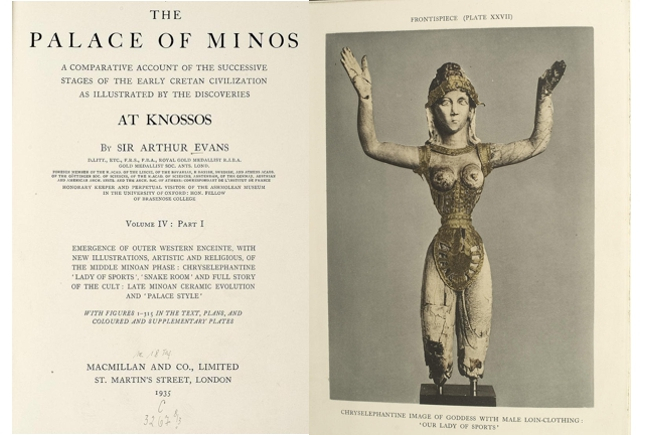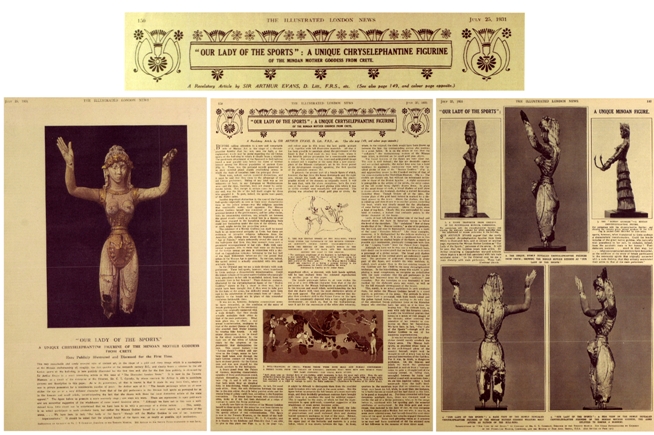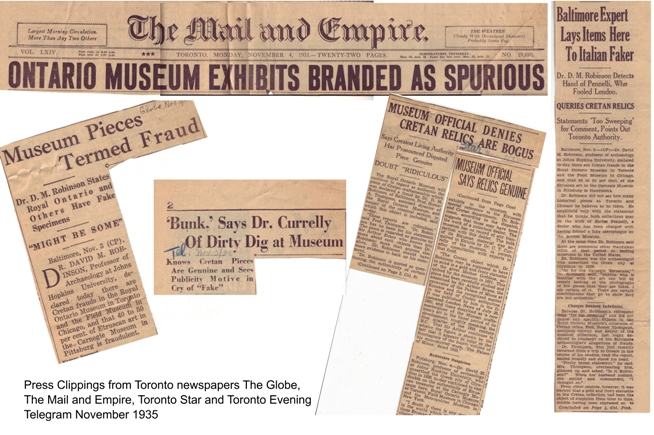The 'Goddess' and the Museum: The Early Years

The front pages of The Palace of Minos volume 4, published by Sir Arthur Evans in 1935
This is the first of a series of articles that Julia Fenn and I will be writing over the next months as part of the research project about a ROM icon: the ‘Minoan’ Ivory Goddess.
For the first three instalments I have been combing the museum records and archives to unravel the complicated history of the figure in the ROM over the last 80 years, from the moment it was acquired to the present, and to examine the rollercoaster of its reputation from star attraction to an object of dubious authenticity consigned to the storeroom. Part of the fun of this type of research has been reading old letters and reports to piece together the story from different sources, but there are obviously many records scattered throughout the ROM and I know that I haven’t yet found them all. If you know of any I’ve missed, do let me know by leaving a comment!
The Early Years
The figurine was bought by the museum in 1931 from Charles T. Seltman, a specialist in ancient art, Lecturer at Cambridge University and a dealer in antiquities, who had already provided the ROM with several objects. It was then believed to be an unusually well-preserved and finely-carved ivory figure of the Middle Minoan III period, made on the island of Crete around 1500-1600 BC, and authenticated, indeed admired, by Sir Arthur Evans, the authority on Minoan Crete. The unusual costume, made of sheet gold, identified her as a female bull-leaper. She wore the wide belt and codpiece or ‘Libyan sheath’ worn by athletes in Minoan wall-paintings, together with a corset that bared her breasts, which was usually combined with a long flounced skirt in images of Minoan women.
The first tantalising mention of the object was in a letter from Seltman to J. H. Iliffe (Keeper of the ROM’s Classical Collection 1927-1931):
“I have a Cretan piece…..which puts even the Boston snake-goddess in the shade, and which Evans regards as the finest Cretan work-of-art extant….”
(letter from Seltman to Iliffe, 16th November 1930)
Seltman was a good salesman and after allowing the anticipation to build, he sent details and photographs of the figure in January 1931. He stressed the remarkable state of preservation with very little restoration, as well as comparing it again to the ivory ‘Minoan’ snake goddess already in the Boston Museum of Fine Arts, a long-established American museum. He was charging the exorbitant sum of £2,750 and although the newly-founded ROM didn’t have that sort of money available, during the Great Depression and just when it was planning a large extension to the museum building, it agreed to pay in instalments. Charles Trick Currelly, director of the ROM and himself an archaeologist, supported the purchase because of the significance of the piece, and because it would establish an international reputation for the ROM as a serious archaeological museum able to compete with older-established institutions.
“I must add on behalf of Currelly, the Museum, and myself that we are very grateful to you for letting us have the first offer of such an important and magnificent piece …..her acquisition by Toronto would do as much as anything could to make people realize that Canada was taking a hand in matters archaeological.”
(letter from Iliffe to Seltman, 17th January 1931)
The figurine arrived at the museum in February 1931 and by March she was on display in the Greek Room on the second floor of the museum, then just the west wing of today's museum, the Heritage Building that runs beside Philosopher’s Walk (this article briefly outlines the history of the ROM’s buildings).
“The bull-leaping dolly is now in position and has been much admired”
(letter from Iliffe to Seltman, 16th March 1931)
But although she was admired in Toronto, to establish the reputation of the ROM internationally the figurine had to appear to the world, and that meant it had to be published. The figurine made her international debut in July 1931 when she was published in the Illustrated London News by none other than Sir Arthur Evans.

The ROM figurine's public debut in the Illustrated London News, July 1931
Evans had been planning the publication ever since he had first seen the figurine in 1930, and Currelly recognised this as the best publicity possible. Evans was the acknowledged expert on Minoan Crete. Essentially he discovered the Minoan civilisation through his excavations of the Minoan palace of Knossos on Crete, which began in the early 20th century (how far the Minoan civilisation can be understood as Evans’ creation will be the topic for another article in this series). Evans lent his expert authority to the new museum acquisition, declaring that the figurine, which he named “Our Lady of the Sports”, was the patron goddess of bull-leapers.
“You will see that I regard the image not as that of a performer in the games, - as I think had been the impression of Seltman and others – but as the goddess herself in the quality of patroness of the Arena – “Our Lady of Sports” – I hope that this idea which I think adds to the interest of the figurine may commend itself to you.”
(letter from Evans to Currelly, 25th July 1931)
The following year the goddess was published by Charles R. Wason (the new ROM Keeper of the Classical Collection 1931-1933) in the Bulletin of the Royal Ontario Museum of Archaeology (March 1932).
These early publications briefly described the figurine, but were more concerned with putting her into the context of the Minoan civilisation. They focussed on recreating the Minoan bull-leaping ritual, through studying other Minoan evidence, and drawing parallels with contemporary Spanish bull-fights. They also showed how new archaeological discoveries had uncovered proof of the Greek myths, the stories of King Minos and the Minotaur, Theseus and Ariadne.
“whereas to the Greeks, Crete was merely a dim memory…..for us the triumph of the spade has made the palace of Minos a reality known not from legends but from the objects themselves...”
(CR Wason 'Cretan Statuette in Gold and Ivory' Bulletin of the Royal Ontario Museum of Archaeology, March 1932, p.12)
But it was in 1935 that the goddess became firmly established as one of the star remains of the Minoan civilisation when Evans published her in the 4th volume of his multi-volumed work The Palace of Minos. Her colour illustration featured as the frontispiece and he devoted over 20 pages to description and discussion.

It wasn’t long before international recognition also brought bad publicity. In 1935 a remark made in a lecture by David M. Robinson (Professor of Archaeology at Johns Hopkins University and a Greek vase specialist) exploded into Canadian newspapers with sensational reports of fake antiquities in museum collections. The ROM was accused of having fakes in the Cretan collection – specifically the goddess figurine. The claims were calmly refuted by Homer A. Thompson (Keeper of the Classical Collections 1933-1947), and amusingly, but less tactfully, dismissed by Currelly. It turned out that the press had misunderstood Robinson’s remarks, which were actually referring to Etruscan fakes from the collection of a notorious dealer, none of which were in the ROM.
"I am sorry to say that a chance remark of mine.… has been grossly exaggerated and has been spread all over the United States and Canada…..as a matter of fact I said just the opposite from what the newspapers quoted me as saying."
(letter from Robinson to Thompson, 11th November 1935)
The ROM goddess was given a reprieve, but this episode was a sign of things to come…..
In my next instalment, The Goddess and the Museum: Museum Attitudes, I’ll be looking at the more recent history of the goddess.
Further Reading
C.L. Cooper (Kate Cooper), 'Biography of the Bull-Leaper: A 'Minoan' Ivory Figurine and Collecting Antiquity', in Cooper C.L. (ed) New Approaches to Ancient Material Culture in the Greek & Roman World (Leiden: Brill, MGR 27, 2021)
